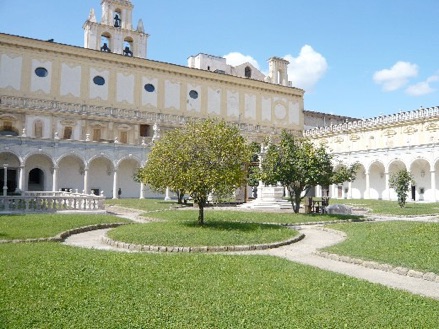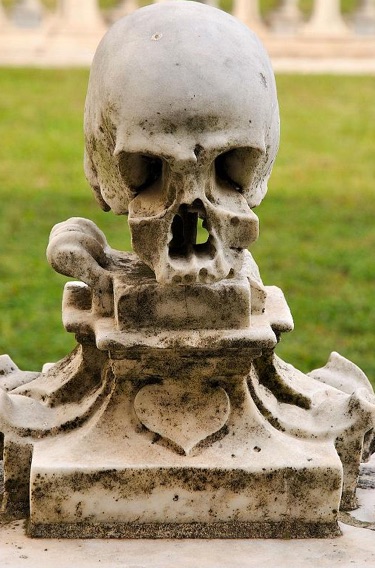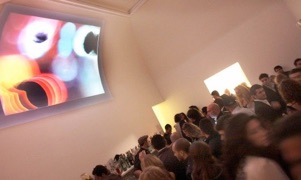GALLERY






ST. MARTINO CERTOSA AND MUSEUM
TOUR DESCRIPTION

The Certosa of San Martino, situated on the Vomero hill, is the most important evidence of the XVI century neapolitan civilization It was founded in 1325 by Carlo Duke of Calabria, eldest son of Robert of Anjou, but was rebuilt in the late XVIth and mid XVIIth century. The work was entrusted to Tino di Caimano, Francesco di Vito and Mazzeo di Malotto . The church was consecrated in 1368 and was dedicated to San Martino, San Bruno, to the Virgin and All Saints. For almost two centuries was enriched with decorative works, until you reach the XVIIth century when it became involved in the site more artistic personalities of the time, including Battistello Caracciolo, Jusepe Ribera and Giovanni Lanfranco. With the French occupation in 1799 began the decline of the Certosa: the Carthusian monks were sent off, guilty of Jacobinism, and after several subsequent returns and departures, were finally expelled in 1836. Suppressed the religious orders and became state property, the Charterhouse in 1866 is intended to "historical museum" by Giuseppe Fiorelli, attached to the National Museum as a branch and open to the public in 1867.
The magnificent view enjoyed from the square, with the view of Spaccanapoli, making it possibly the best view of the city of Naples.
The entrance leads to the courtyard built by Giovanni Antonio Dosio who also designed the Church of Women, located in the square, decorated with a stucco seventeenth century.
The church is preceded by a pronaos fourteenth century, originally of five arches, later reduced to three by Dosio to get two new chapels. The work of the facade were then terminated by Cosimo Fanzago. The interior was transformed in '500 of three naves with a single nave with side chapels, richly decorated in the next century with elegance and taste coloristic Fanzago by Cosimo, who, from 1623 to 1656 he led the work of decoration with marble garlands of flowers and fruit . The marble floor of the nave is that of Fra Bonaventura Presti reused some inlaid marble from Fanzago. On either side of the entrance are two statues always Fanzago, which was finished by Alexander Swift, also, always near the portal, they are also two paintings by Jusepe de Ribera and above the doorway of a deposition Massimo Stanzione. The ceiling is enriched by a series of paintings by Giovanni Lanfranco hiding structures cross coverage. On the right are the Chapels of St. Hugh, the Baptist and St. Martin, left the San Gennaro, San Bruno and the Assumption. In the chancel is built of hard stone balustrade design Tagliacozzi Channel, but the altar is built and designed by Francesco Solimena and executed by Giacomo Colombo. The apse has a marble floor and a magnificent wooden choir Fanzago of 1629. On the back wall are statues of Bernini and Pietro Giovanni Battista Caccini and a Nativity by Guido Reni. The frescoes are by Cavalier d'Arpino and Giovanni Lanfranco. On the right wall there are frescoes of Stanzione, Carletto Caliari; in the left hand are the frescoes by Jusepe de Ribera and Caracciolo Battistello.
The Chapter Room is decorated with a wooden choir in 1627, with frescoes by Belisario Corenzio and numerous other works of artists like Finoglia, Battistello Caracciolo, Massimo Stanzione, Francesco De Mura and Avanzino Nucci.
From a side door leads to the chorus of Conversi, with tapestries and carved wooden stalls painted with scenes from the Old and New Testament stories and the lives of Carthusian monks.
Along the corridor leads to the Magdalene Chapel, decorated with frescoes and prospective altar a painting of Mary Magdalene, by Andrea Vaccaro.
Hour
Every day from 8.30 am to 19.30 (last admission 18.30)
Closed 1th January,1th May and 25th December
Closed on Wednsday
Rates of entry
Full € 6,00
Reduced € 3,00 (*)
Monday Free entrance
Free
for EU citizens under 18 years
(*) Reduced: for EU citizens aged between 18 and 25 years of age and for school teachers of the European Union.
The free tickets and reduced may be issued only upon presentation of a valid identity document.
For schools visiting the reservation is mandatory.
How to arrive
Roads and Transport:
Montesanto Funicular: stop Vomero;
Central Funicular: stop Vomero
Chiaia Funicular: stop Vomero
Bus V1: Piazzale St. Martino
The monastry of St. Martino presents amazing views over the city of Naples and a number of masterworks of the Baroque art.
Tour Price: 90 €/hour
Tour type: Art and History tour; Private tour; Walking tour.
Duration: 2 hours
Running days: Every day
Maximum travelers: 14 (a small group guarantees a service of better quality) Tours for larger groups can be arranged on demand.
Main attractions: the church, the monastry, the cloisters and the Orilia Collection of ancient art, the Bourbons boats and the Nativities dating back the XVIII century.
What’s not included: Entrance ticket (8 €); Transportation (It can be arranged with Mercedes Limousine, Mini Van or Bus; Hotel pick-up or drop-off)
Kid Friendly: Yes

I can arrange an itinerary for people with reduced mobility.
The Orilia Collection was donated to the State by the wife of Marcellus Orilia and includes furniture and wooden furniture of the the XVII century Capodimonte porcelain and other major origins (Ginori, Volpato, Meissen), fans, glasses, vases and wooden statues.
The Naval Section includes various models of real boats, including two battleships, Battleship Battleship King Umberto and Queen Margherita, the cacique turkish elegant Lancia and twenty-four oars Naples gave to King Charles of Bourbon. This section was reopened in 2008 after a thirty-year closure for reasons of dilapidated environments.
The Fourth of Prior, representing ancient apartment where guests were received about the most, is made up of various rooms and gardens, chapels and lodges. After the transformation of the Charterhouse Museum in this area was intended to accommodate paintings and works of art collection of the famous Carthusian. Testimony of the ancient collections are the tables of Jean Bourdichon with the Madonna and Child, Saints and Crucifixion, and the doors of the triptych of a Hispano-Flemish painter unknown, the last quarter of the fifteenth century, with portraits in the guise of the Magi , of King Robert of Anjou and his son Charles of Calabria. In the open courtyard that once was is now exposed one of the masterpieces of sculpture from the early seventeenth century: the Virgin and Child with St. John by Pietro Bernini.
In the open courtyard that once was is now exposed one of the masterpieces of sculpture from the early seventeenth century: the Virgin and Child with St. John by Pietro Bernini.
Shortly after the birth of the museum, inaugurated in 1879 Section Crib, with the arrival of the spectacular crib Cuciniello, the donor's name, prepared by an artificial cave carved from an ancient environment of the kitchen of the Certosa, enlivened by numerous figures of shepherds , animals, still lifes by the spectacular parade of the Eastern Magi, inventory of popular eighteenth century. And 'an important document of the typical eighteenth-century Nativity scene. Here with us are the rarest pieces of the production of pastorari Neapolitans, known throughout the world.
The Cabinet of Drawings and Prints has about sixteen thousand sheets, stands for quality and quantity next to the collection of the Museum of Capodimonte. The chart comes from various heritage collections: architectural drawings, the work of Vanvitelli and Antonio Niccolini, including the sets for the Teatro di San Carlo, the figure drawings of the XVII and XVIII centuries, and those seen by Giacinto Gigante and the the School of Posillipo. Remember the bottom of prints with the maps of Naples, the sheets of the various Italian and foreign sectors of the seventeenth and eighteenth century, collections of portraits and historical subjects Neapolitans.
The exposure in the section on artefacts Decorative Arts is located upstairs and includes the historical collections of the Museum with donations Bongs, Savarese, Ricciardi, Ruffo di Bagnara. There are numerous pottery, porcelain, glass, mirrors and precious items such as ivory or coral, from the sixteenth to the nineteenth century. Of particular importance is the monumental group of Apollo's Chariot. Many come from the porcelain factory of Capodimonte, France, decorated to Naples by Raffaele Giovine and the collection includes the production of Murano glass from the fifteenth century.
In 2004 he opened the Chamber Theatre, which presents the history of nineteenth-century Neapolitan theater through models to the real theater of San Carlino, drawings and set designs, documents and portraits of the protagonists of the theatrical life of that time as Saverio Mercadante, Salvatore Di Giacomo, Eduardo Scarpetta, Raffaele Viviani and Antonio Pepito.
In environments of the ancient quarters of the Certosa is the section devoted to the nineteenth century. Created to document the historical events of Naples and the South. Major purchases and donations have increased over time the collection, with works like the Maries to Calvary by Domenico Morelli, the landscapes of Theodore Duclére and Giacinto Gigante, Pastorelli of Abruzzo Michetti, the famous Prevetariello by Antonio Mancini.
On the ground floor and first floor houses the Image section and the memory of city images and objects in the history of Naples from the fifteenth to the nineteenth century, the monarchy and angiona aragonese the Spanish viceroy, the reign of the Bourbons, until the unification of Italy . Age is the Tavola Strozzi aragonese depicting the view of Naples from the sea in the second half del'400, the return of the Aragonese fleet. Works devoted to the revolt of Masaniello in 1647 with portraits of the characters and episodes and related to the tragedy of the plague. Along with depictions of the city, there are portraits of the kings of the House of Bourbon and a selection of the amount of 'historical memories' of the Bourbons. An entire room is dedicated to the revolution of 1799 memorabilia, medals, coins and portraits.
INFO

From the left box of the apse wall leads to the sacristy, a large room full of inlays, with frescoed ceiling and the Chapel of the Treasury, which has masterpieces like the Pietà Jusepe de Ribera on the altar, and once in the Triumph of Judith commissioned the painter Luca Giordano latter in 1703 and completed the following year. Another fresco by Luca Giordano, the Stories of the Old Testament, Old Testament depicts four heroines and are located at the four sides of the room, in the apse is the representation of the Adoration of the Brazen Serpent in the lunettes and other side depicts five scenes. The floor is decorated with geometric patterns, but equally important are the inlaid cabinets that contain the sacred vessels.
The cloisters were built in the XIV century, together with the monastery but were completed after fifty years under the reign give Joanna I of Naples. The Cloister of Prosecutors with portico and loggia is connected through a corridor to the hall of the refectory and the center has a well made by Felice de Felice, with a bowl decorated with references to the Great Cloister pit constructed from the existing Dosio Angevin monastery, refurbished by Fanzago reducing to sixty arches and columns on which they rested sixty-four. The materials used were the gray and white marble and Piperno. At its center is a "fake" Well, actually a light to the huge underground reservoir that is accessed via a ladder.
The Museum was opened in 1867, by Giuseppe Fiorelli. Many works came from the territory as evidence of the history of Naples and its artistic culture. This heritage was later increased by donations and private entities.

Archaeological tours, packages and exclusive multy day excursions in Campania for tourists, lovers,
scholars and students.

BUY NOW THE TOUR OR MAKE A RESERVATION PAYING
A 60 EUR DEPOSIT

Copyright © Pompeiin.com - E-mail: info@pompeiin.com

túra tárlatvezetés Pompeii екскурзии на Помпей вођене туре Помпеји visites guiades a Pompeia prohlídky Pompejí vodstva od Pompeja guidede ture i Pompeji opastettuja Pompeijin des visites guidées de Pompéi მართვადი ტურები pompeii ポンペイのガイド付きツアー turais threoraithe Pompeii leiðsögn um Pompei тури на Помпеја guidede turer pompei rondleidingen
شهر پمپی راهنما van Pompeii zwiedzanie Pompei ทัวร์เมืองปอมเปอี visitas guiadas de Pompéia tururi ghidate ale orașului Pompei Экскурсии Помпеи prehliadky Pompejí vodene oglede Pompejev visitas guiadas a Pompeya guidade turer i Pompeji Führungen von Pompeji Pompei'nin rehberli turlar Екскурсії Помпеї tárlatvezetés Pompei 폼페이 투어
udhëzues Pompei - Кіраўніцтва Пампеі - употреба Помпей - guia de Pompeia - Průvodce Pompeje - vodič Pompeji - aktiviteter i Pompeji - juhend Pompei - Guide de Pompéi - treoir Pompeii - fylgja Pompeii - водич Помпеја - gids pompeii - Podręcznik pompeii - guia de Pompéia - Ghidul Pompei - Руководство Помпеи- водич Помпеја - Sprievodca Pompeje - vodnik Pompeji - guía de Pompeya - Guide Pompeii - kılavuz pompeii - Керівництво Помпеї - útikönyv Pompeii - ガイドポンペイ - გიდის pompeii - 가이드 폼페이 (Pompeii) شهر پمپی تور
кіраўніцтва Пампеі - Помпей - guies Pompeia - příruček Pompeje - 指南庞贝 - 指南龐貝 - 가이드 폼페이 (Pompeii) - vodiči Pompeji - guider Pompeji - juhendid Pompei - gabay Pompeii - oppaita Pompeii - guides Pompéi - guías de Pompeia - canllawiau Pompeii - გიდები Pompeii - ガイドポンペイ- गाइड Pompeii - panduan Pompeii - handbækur Pompeii - ceļveži Pompejas - vadovai Pompeii - водичи Помпеја - gwidi Pompeii - guider Pompeii - gidsen Pompeii - راهنمای گر شهر پمپی Prowadnice Pompeii guias de Pompéia ghiduri Pompei Руководства Помпеи
водичи Помпеја príručiek Pompeje Vodila Pompeji guías Pompeya Guider Pompeji ปอมเปอีแนะนำ Führungen Pompeji kılavuzları Pompeii керівництва Помпеї útmutatók Pompeii
Pompeii Tour guide - Herculaneum Tour guide - Pompei and Herculaneum tour - Stabiae Tour guide - Oplontis Tour guide - Naples Tour guide
Amalfi Coast - Sorrento - Positano - Paestum Tour guide - Capua Amphitheater - Procida - Ischia - Capri